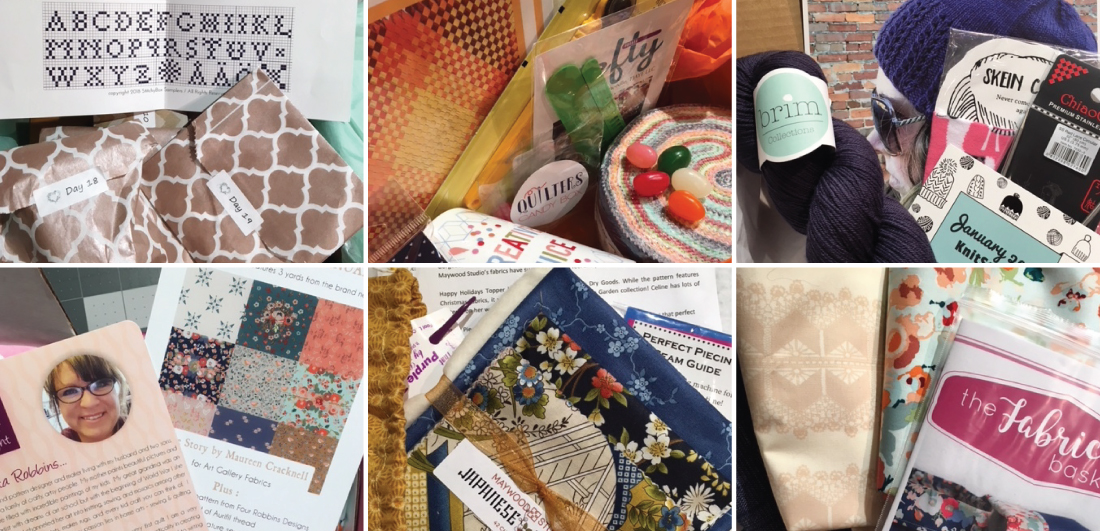
We reviewed several craft and creative boxes, receiving complementary boxes that were subsequently donated to a quilt guild for its annual charity auction. The photos in this article are highlights of subscription box packaging and contents.
All photos by Joanne Cleaver
“It’s like hiring a personal shopper,” says Tracy Horner, a cross-stitch designer based in eastern Washington state, of the consumer appeal of subscription boxes. She gets it: consumers love the combination of surprise and predictability that such boxes deliver monthly through a curated selection of goods based on a tightly-focused theme.
For designers and makers, subscription boxes potentially offer exposure to new enthusiasts who might not frequent retail stores, shows, or know how to find specific goods online. Horner, an electrical engineer by day and owner of stitch design firm Ink Circles by night, says that for her, participating in Stitchybox has amounted to “a marketing tool that pays for itself.”
Designs like Horner’s hipster cross-stitch (think skulls or beer bottles) are precisely what it takes to grow Stitchybox, says Liz Westlake, of Seattle, who launched and runs the sub box. Opportunities for designers and makers abound, but the rules are still evolving for this fast-growing industry. There’s plenty of room for suppliers to negotiate deals that address their own marketing and growth goals.
The box craze was touched off ten years ago with BirchBox, a cosmetics sampler. Birchbox fills small cardboard boxes with product samples, procured at low or no cost from manufacturers, and delivers them for a $10 a month fee per subscriber. The ‘unboxing’ experience – perpetuated by ‘unboxing’ videos on YouTube that lets viewers vicariously share the experience of opening a box – has spawned a subculture that celebrates the moment nearly as much as the contents – at least, for inexpensive boxes with mass-market appeal.

Cotton Cuts makes its social media ask front and center, on the inside lid of the box, where subscribers will see it first and often.
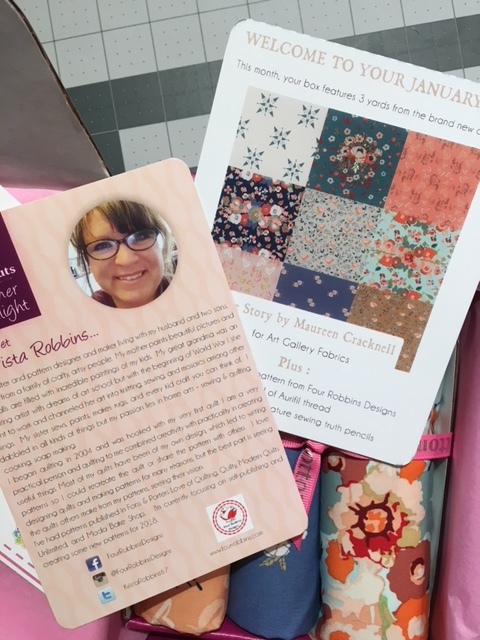
CottonCuts highlights the brands and designers whose goods are included its boxes.
Craft and creative subscription boxes are one of the main categories within the estimated 2,000 types of boxes, according to data compiled by Schorr Packaging Corp., a cardboard box manufacturer with an obvious stake in the success of the industry. Schorr reports that 58% of sub box website visitors are women, with a median age of 41, and a median income of $78,436. But, success in the industry is far from guaranteed. About 13% of sub box companies tracked by sub box review site My Subscription Addiction are reportedly defunct.
The craft and creative box category has developed a different business model than the mass-appeal consumer goods boxes. “Where we differ from a Birchbox is that they’re samples and we’re experience,” says Megan Graddy, of Atlanta, who, with her mother, Amy Rosenbaum, runs PostStitchBox, for knitting and yarn enthusiasts.
Unlike mass-market boxes that essentially redistribute product samples, owners of sub box companies designed for adult craft enthusiasts expect to pay for the contents. Typically, box owners negotiate wholesale rates (though they’d like to get even better terms if they can). It’s often worth it for suppliers, given that successful boxes usually have 200 to 400 monthly subscribers, constituting a healthy wholesale order.
Westlake launched Stitchybox as an evolution of her hand-dyed fiber operation. She pulls together themed boxes – in essence, glorified kits – as well as seasonal boxes that feed the right materials at the right time for stitchers aiming for holiday gift-giving. The boxes cost $35 to $65 each, depending on the theme, amount, and unique quality of the contents. Close collaboration with designers is integral to the value she offers subscribers, who’d rather have a few skeins of specialty fiber than a fistful of chain-store floss.
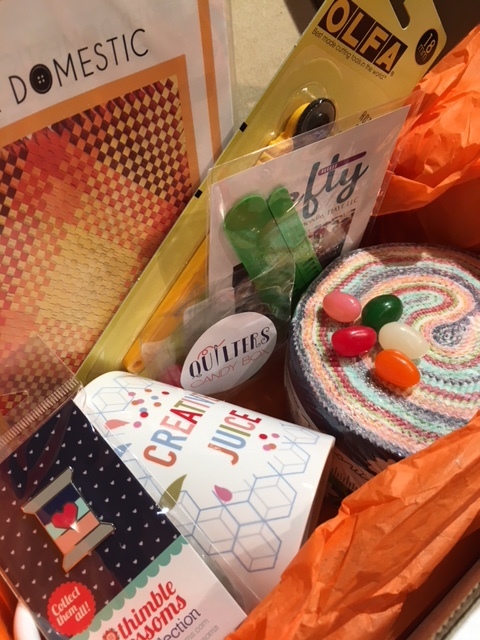
The QuiltersCandy box lives up to its name, with actual candy (we shook the jelly beans from their little bag for illustration purposes), as well as an array of quilting tools and materials: a pattern, a jellyroll of precut Moda fabric, and tools.
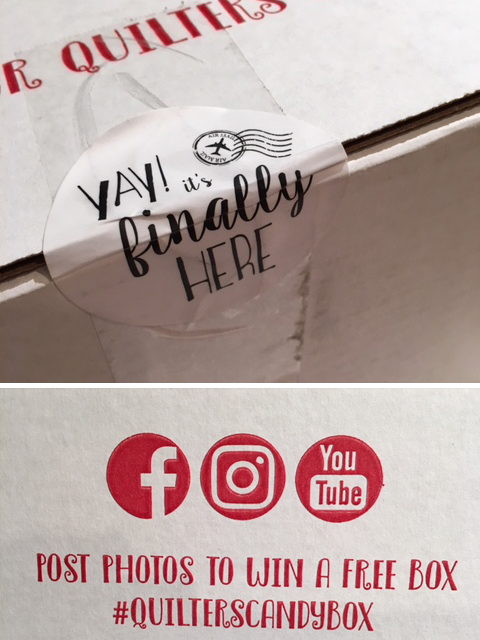
Sub box companies build anticipation at every step, as illustrated by this cheerful sticker decorating a QuiltersCandy box. In addition, social media sharing creates community, supports interest and is key to drawing new subscribers, so box companies urge subscribers to share their boxes and finished projects at the companies’ social sites.
Because sub box owners sell curated selections, they might need designers even more than designers need them. An affiliation with an established designer raises the sub box profile and illustrates the quality they promise.
British handknit designer Jo Torr says she bases the amount she charges for a pattern for a sub box on how much she might make by marketing the design on her own. Overall, she says, subscription box owners “do a good job of promoting your design, provide fantastic photography, and make their subscribers feel that they’re lucky to have one of your designs. This is when customers come looking for your other patterns and it becomes the start of a long-term relationship.”
Therein lies the holy grail for designers and makers: how to convert box subscribers to their own following of customers and fans. Too often, suppliers overlook the opportunity to cross-market via social media, blogs, and subscription box email newsletters. Graddy, of PostStitchBox, estimates that only about 10% of her suppliers send along cards or any type of printed marketing material to include in the box that includes their goods. “If they’d send me something Facebook-worthy, I’d give them Facebook time,” says Elaine Huff, who runs Patchwork Parcel, a monthly self-contained project, from Park City, Montana.
Box companies often have social media followings much larger than their actual subscriber base. Typically they are eager for content from suppliers to share – both in advance, to drive last-minute subscriptions – and after box delivery, to fuel envy that might convert to subscribers. For instance, Pins + Needles Kits, a quilting box based in Fort Worth, Texas, has 300 subscribers and a social media following of 3,000, says co-owner Kellie Rushing. She coaches suppliers to create special offers she can cross-promote to subscribers and followers with the aim of capturing customers for both the box and the supplier.
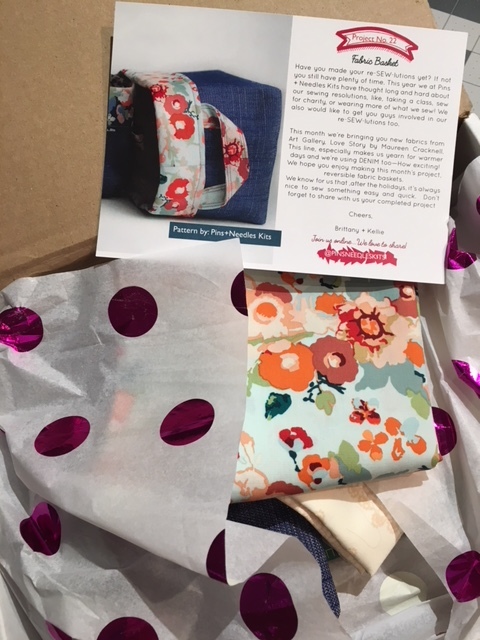
Pins&Needles subscribers first see a card showing that month’s project.
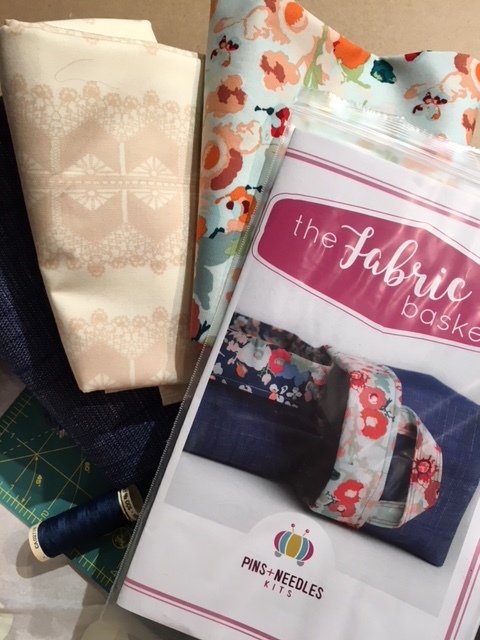
The Pins&Needles box includes everything the subscriber needs to complete that month’s project, including thread.
Successful subscription box companies are experimenting with additional selling channels, opening new venues for established vendors. Kim Moos operates four quilting boxes, each with a different theme, from her St. Louis-based company Cotton Cuts, LLC. She negotiates a wholesale price with quilt pattern designers and, instead of including a printed pattern in each of the themed boxes, includes a card that subscribers can use to download the patterns. This has fueled a variety of collaborations, she says, including an international partnership with a New Zealand ‘mystery quilt’ designer. Consequently, Cotton Cuts is adding additional online retail channels so that subscribers can buy fabric by the yard.
Box owners can also offer video tutorials and custom designs created exclusively for their subscribers. LetteringBox, a calligraphy-themed box based in Overland Park, Kansas, now commissions posters and designs for its 400 subscribers, says managing partner Rita Simmons. “We’ll have artists takeovers in which the artist takes over the whole box and shows their entire process,” says Simmons.
As the industry grows, celebrities and creative ‘influencers’ are starting to catch on to the steady revenue delivered by boxes that translate their brands to goods. Inked Brands, based in Bowling Green, Kentucky, got its start ten years ago as a scrapbooking subscription box. Now, founder and CEO April Foster runs a 200-employee company that designs and delivers boxes of its own and on behalf of celebrities with established and fast-growing followings.
Inked is expanding its roster of contract designers for product development and marketing, says Foster, and aims to coach those designers in building their own brands and following, too. ““We make sure all our artists are featured, whether that’s putting their name on the packaging, or putting a profile of them in the orders, or doing a video with them. It’s hard to measure what that means, but we know it helps them grow,” she says.
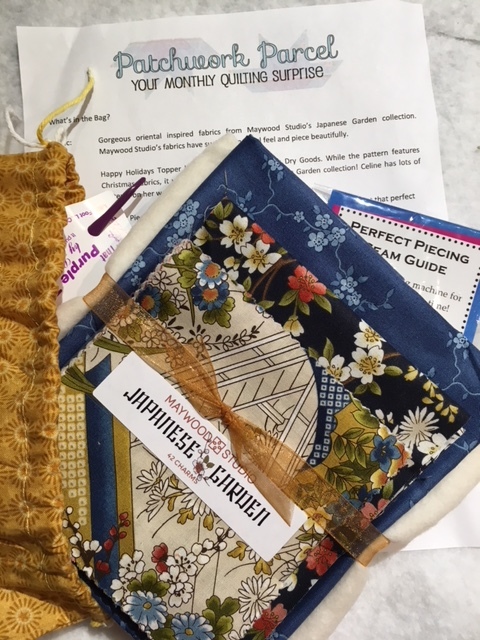
Patchwork Parcel box usually includes fabric, tools, and often, a sample size of a new product or material.
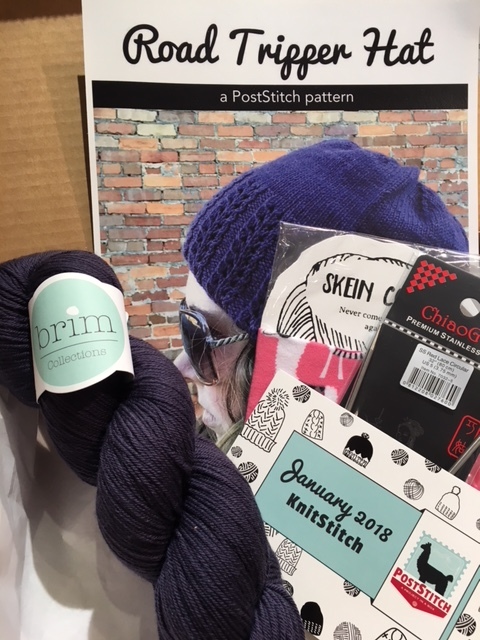
PostStitch has developed its own brand of patterns and pairs them with small-batch yarn.
Tips for getting your work featured in subscription boxes
How Subscription Boxes Are Different From Retail Stores and from Selling Online
The promise is non-negotiable. “We know what we are promising months in advance,” says Elizabeth Chappell, owner of Quilters Candy Box, based in Houston. That means that suppliers must guarantee delivery of sufficient stock, absolutely on time. Boxes are assembled in the month before the promised ship date and box companies do not have wiggle room for substitutions or shortages. They must fulfill the precise promise of the box.
Curation is brand. Because box managers promise to deliver a surprise, it is common for designers to be featured only once a year, at most. Developing a relationship with a box company will probably not result in large-scale, frequent sales.
Exclusivity rules. ScribeDelivery, run by Chad Ettelbrick, of Frisco, Texas, delivers hard-to-find calligraphy pens, pencils, and journals to its members. Because its mission is to bring them writing supplies they probably can’t find in stores, Ettelbrick says he rotates the selection to fulfill the promise of delivering unusual items. Like most box operators, he says he’s unlikely to feature the same exact items too often, because subscribers want to be pleasantly surprised, not to experience déjà vu. You are more likely to be included if your product is new and not yet widely distributed.
One-time collaborations open new opportunities. Box owners say they are eager to work with new suppliers. One way, says Graddy from PostStitchBox, to gain a toehold in the industry is to collaborate on a kit or project with a complementary supplier: in other words, if you are a designer, collaborate with a materials supplier, and vice versa, to develop a project unique for a box.
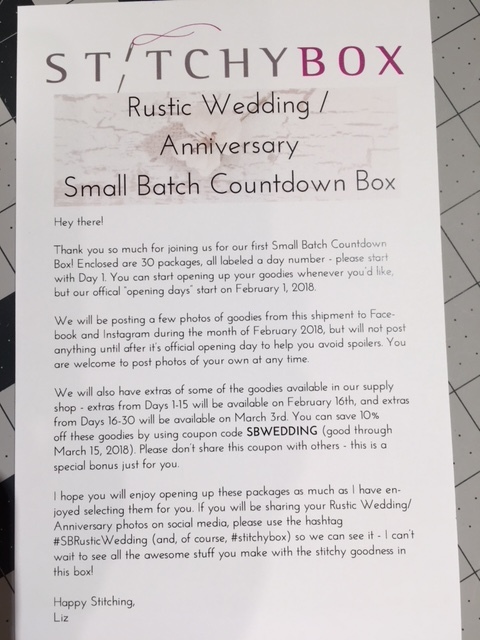
Stitchybox has launched a monthly countdown boxes that walks subcribers through a project for a specific event – in this case, a wedding.
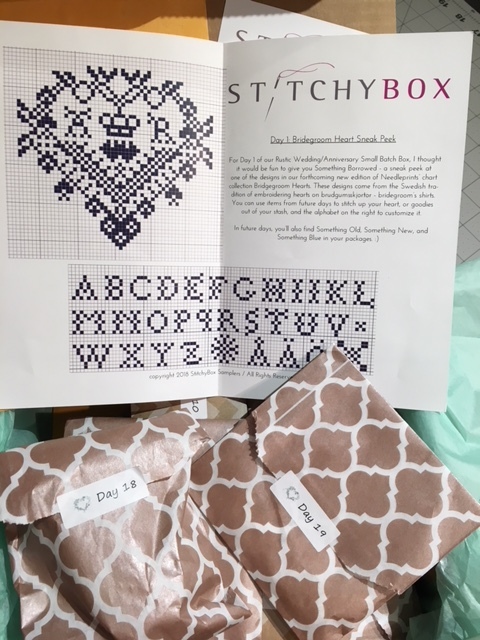
To get subscribers started, Stitchybox includes an orientation to the month’s worth of project steps and materials.
Subscription Box Negotiation Points
- Show the box owner exactly how your design or goods will be presented in the box – send full samples with the finished packaging so the box company sees exactly what would be included.
- Expect to offer a bulk discount – wholesale terms at least.
- Provide marketing cards that can be inserted in the box and that include a discount or special offer code for customers who buy directly from you.
- Find out if you can include a tiny sample in advance to tease your participation in an upcoming box.
- Label goods with special tags or labels with your website or other contact information.
- Be sure that your contract specifies that you can get back goods sent if the box company shuts down.
- Ask about themes and special offers that the box company might be planning.
- Ask if the box company will expand its offerings in advance of Christmas or other relevant dates.
How to Vet A Subscription Box Company
- Box companies that are serious about working with new suppliers have ‘work with us’ contact information on their websites, usually in the footer.
- Review ‘unboxing’ videos to see how the company presents to its customers.
- Analyze consumer reviews. Liz Cadman founded review site My Subscription Addiction in 2013 and now pulls in a million unique viewers every month. “People search for reviews of boxes before they subscribe,” she says. New box companies seek to have their boxes reviewed by My Subscription Addiction and Cratejoy, a site that both offers reviews and box fulfillment services. (Cratejoy did not respond to repeated requests for an interview for this story.)
- Also analyze reviews for competing boxes. What is genuinely unique about the box company you are considering approaching?
- Look up the box at social media sites, especially Facebook, Instagram, and YouTube, and determine the size and enthusiasm of the box company’s following.
Enjoyed this piece? Read our other article about collaborating with subscription box owners and tune into our webinar with subscription box coach, Moira Fuller.

Joanne Cleaver
contributor
Joanne has been writing about entrepreneurship for 30 years and quilting for 40 years.

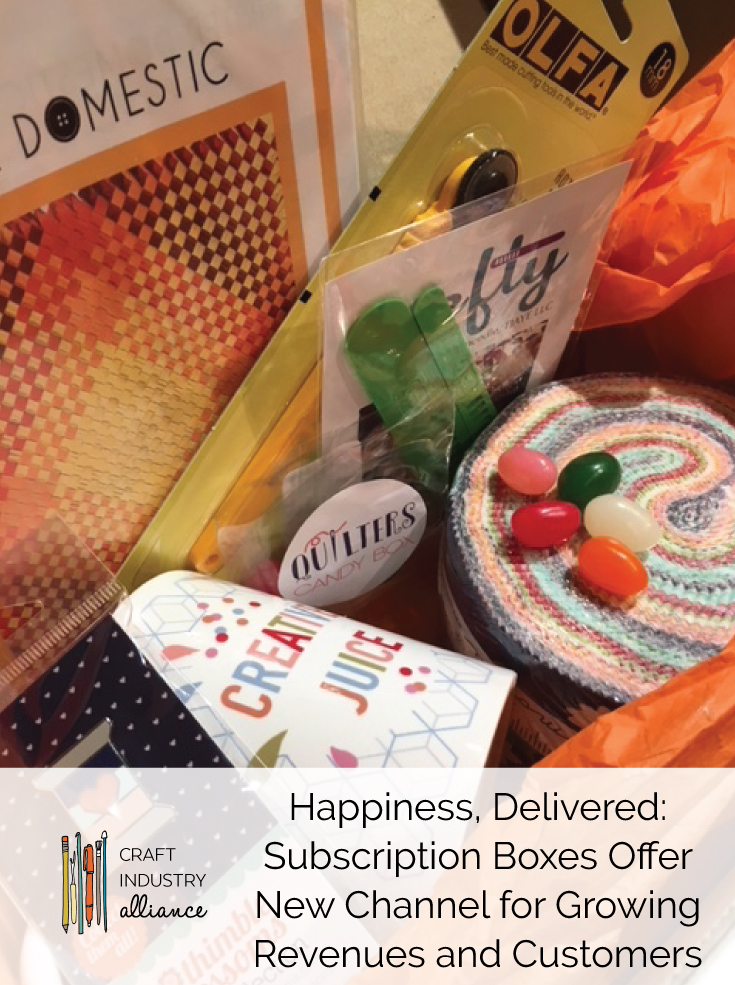
I have asked three times that my subscription be stopped. I cannot afford it at this time.
Josh, You’ll need to reach out directly to the subscription box company. We aren’t affiliated with any particular subscription box so I’m afraid we can’t offer customer service for those. Thank you.
Scrapbooking companies had subscription boxes in the early 2000s! There were a few at first, then an explosion of options, all containing materials to create a several page spread in a 12″x12″ scrapbook, or a set of cards, or mini-book project. The market definitely got saturated! But at its height, there must have been dozens of monthly subscriptions offered, and much discussion of which were best on the scrapbooking forums.